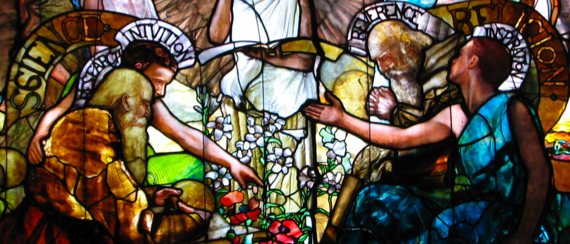
Every Monday, “Science and the Sacred” features an essay from one of The BioLogos Foundation’s co-presidents: Karl Giberson and Darrel Falk. Today’s entry was written by Darrel Falk.
Michael Behe chose the mouse trap as his everyday example of a household gadget that was irreducibly complex. The structure of each part only makes sense in the context of how it functions with each of the others. Behe could just as easily have chosen the light switch. From the little lever that you flick with your fingers to parts of the internal mechanism that open and close the electrical circuit, each component is structured to carry out its function as part of the entire unit: each constituent is built with the end in mind. In Behe’s terms then, a light switch is also irreducibly complex.
According to Behe’s definition, the nano-switches that turn genes off and on are also irreducibly complex. I have had the immense privilege of spending my career as a biology professor. Without question, my favorite part of teaching has been the discussion of irreducibly complex structures, especially those switches that turn the expression of genes off and on. Just like when you turn a light switch on, and the bulb mysteriously starts to glow, so it is with genes. Most genes, just like most light bulbs, have switches. Turn the switch on and the gene becomes active; in no time at all its product begins to accumulate in a cell. Each switch is unique and each one is exquisitely designed so that it gets “flipped on” at just the right time, and can be “flipped off” when the activity of that specific gene is no longer needed. These are used through development to build the human body, each one designed to be turned on at just the right time and just the right place to build the bone, muscle, eye, brain and all the other marvelous parts of the human body. To learn how the switches work and then to describe their beauty to students has been one of the greatest privileges of my life.
It is important to add that even harmful organisms are built by these switches. Indeed they were first discovered and characterized in the sometimes deadly microorganism, E. coli. These destructive cells are built and kept alive by hundreds of different irreducibly complex switches—each one unique and each one geared towards its specific purpose in maintaining the life of this organism designed to harm us. Some of the most elegant switches are found in viruses including HIV, the virus which causes AIDS, or H1N1, the virus that threatens to terrorize the world this year. There are literally millions of different irreducibly complex structures that function in bacteria and viruses. Each one of these millions is unique. Each one would fit Behe’s definition of irreducible complexity.
So while we may love to think about the Intelligent Designer as being the great engineer in the sky drawing up magnificent plans to make things like the mammalian eye, the blood complement system, the immune system, or even the bacterial flagellum, it is not that simple. Countless millions of these structures and processes are designed to make people very sick and even to kill them.
The Creator described in the Bible is not a sinister God who is off in a great machine shop “intelligently designing” machinery to make people very sick. Some will say that these switches in lethal organisms are a by-product of the Fall–of sin entering the world. But this view that irreducibly complex structures were built in response to Adam’s sin is highly problematic. Remember that these machines are intricately designed. Who is the new creator? Does Satan have power to create? Surely not the Satan of Christian theology–that Satan functions to destroy, not create. The whole story of intelligent design starts getting absurd, and it doesn’t fit with any orthodox Christian theology.
The bottom line, as I see it, is that the concept of irreducible complexity is not only a scientific dead-end (see Part I of this series), it is also a theological dead end. It just doesn’t work, and all discussion of it as a serious possibility ought to stop. It makes no sense theologically, and it makes even less sense scientifically.
So as a Christian, what do I think is the origin of these little pathological killing-machines? They are produced by natural selection, a process that the science of biology shows really does explain how the machinery inside cells is built. God grants freedom to creation just as God grants freedom in our own lives. Humankind has struggled with the problem of bad things happening to people for a long time. That, for example, is the theme in the story of Job written some 3,000 years ago. So there is no new theological problem here. God does not choose to have a world where his creatures function like pre-programmed robots. There is freedom in this world. A by-product of this freedom is that bad things happen to people–they get cancer, they die in car accidents, and they can sustain serious injury when they fall. It is not a big leap to suggest that creation as a whole has a high degree of freedom built into it. Natural selection–in that freedom–builds structures that are good, but it also builds structures that can harm us. Just like an automobile barreling down the highway or like an auto-immune disease that affects the body of one we love, a world of freedom is a world with inherent dangers. God, in God’s sovereignty, chooses freedom for creation.
It is important to emphasize that God-granted freedom does not imply a God-ordained absence. In fact it is quite the reverse. Beginning in the 14th chapter of John, Jesus begins to prepare his disciples for his departure, and immediately he tells them about the immanent Spirit that will be with them. “Surely, I am with you always, even to the very end of the age,” he said in Matthew. And, in Romans 8, Paul in one breath writes about the whole creation groaning, while in the next he writes about the Spirit helping us in the midst of that groaning. The second verse of the Bible speaks of the Spirit which hovers over creation. Although we live in a world gifted with freedom, we also live in a world that is gifted by God’s presence. We can, if we so choose live life in that presence. “Christ-in-you, the hope of glory”–is how Paul describes the indwelling presence of the Spirit in Colossians. So in Scripture we have this mysterious interplay between the ongoing assurance of God’s Spirit and a life lived in freedom including, even, the harmful by-products that freedom brings with it.
There is a unity in this view of life. Some of the by-products of natural selection are intricate structures that can fashion cellular machines that are able to harm us, just like the machines that we humans make. It happens in the context of freedom–God-granted freedom. However, the notion that irreducibly complex structures are built and put in place by a meticulous detail-driven intelligent designer is not consistent with Christian theology and should not have been embraced by Christians. With all due respect to my friends who hold this view, I would venture to say it borders on the heretical–certainly it is scientifically heretical, but I wonder if it is not theologically so as well. God is not the engineer that built these intricate little terror machines. And the Satan that we know from Christian theology is not a designer of life’s machinery. Those who wish to believe this are free to do so, but they have moved onto an island of scientific fantasy and perhaps even theological heterodoxy.
The greatest beauty in the universe emerges through processes that arise through God-ordained freedom. Let us celebrate that beauty, even as we, in the presence of God’s Spirit, grit our teeth, and endure the hardships that come as a by-product.
Darrel Falk is a biology professor at Point Loma Nazarene University in San Diego and co- president of The BioLogos Foundation.

